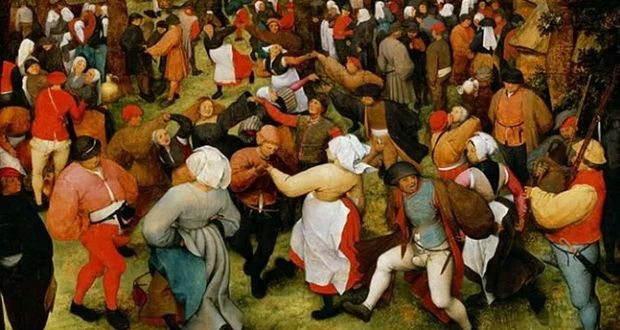Embark on a journey through the annals of human history as we delve into 50 bewildering episodes of mass hysteria that left communities, and sometimes entire nations, caught in the grip of inexplicable fears. From laughter epidemics to phantom attackers, these collective panics transcended geographical and cultural boundaries, showcasing the profound and sometimes bizarre ways in which human minds can synchronize in moments of crisis. Join us as we unravel the tales of shared delusions, strange fears, and episodes of pandemonium that have shaped the fabric of societies, leaving an indelible mark on the tapestry of human experience.
21Louisiana School Twitching Epidemic (1939)

In the spring of 1939, a Louisiana school witnessed a widespread twitching epidemic among its female students, starting with one girl's uncontrollable leg twitch during the annual homecoming dance. The phenomenon escalated, affecting more students and prompting frantic reactions from parents, leading to a chaotic stampede. Investigation suggested that the twitching was a result of attention-seeking behavior by a lovelorn girl named Helen, who, subconsciously, found a way to excuse herself from dance classes and address her insecurities about her dancing skills.
22Milan Plague Poison Panic (1630)

In 1630, King Philip IV of Spain warned Milan of escaped prisoners intending to spread the plague through contaminated ointments. Coincidentally, a real plague outbreak occurred, leading residents to believe they were poisoned, sparking a frenzy of paranoia. The city descended into chaos as people accused each other of spreading plague-bearing poisons, resulting in numerous assaults and even deaths over seemingly innocuous actions.
23U.S. Elementary School "Bin Laden Itch" (2001-2002)

Between October 2001 and June 2002, a mysterious skin rash affected thousands of elementary-aged students in several states in the United States, prompting fears of bioterrorism in the aftermath of the 9/11 attacks. While the rash had no known cause and disappeared spontaneously, heightened awareness due to terrorism fears led to increased reports from students and school nurses. The "Bin Laden Itch," though ultimately non-existent, successfully triggered mass hysteria, with a few students even deliberately causing skin irritation to disrupt schools.
24Penis Panic (1967)

A penis panic is a phenomenon where males believe their genitals are shrinking or disappearing, leading to mass hysteria. These events have occurred globally, particularly in Africa and Asia, with local beliefs suggesting that such changes can be fatal. Injuries have resulted from desperate attempts, including the use of needles and fishing line, to prevent perceived penis disappearance. In 1967, Singapore faced a significant epidemic, prompting a government campaign to reassure men of the anatomical impossibility of retraction and implementing a media blackout on the condition's spread.
25Affair of the Poisons (1679)

In 1679, the Affair of the Poisons unfolded in seventeenth-century France, revealing widespread Satanist hysteria at the royal court and implicating over 300 alleged poisoners. Although initially scandalous, the investigation primarily targeted third-rate alchemists and quacks peddling ineffective poisons. Faced with torture, many falsely accused others, leading to a five-year purge with dozens executed, showcasing a period of blind panic.
26Malaysia School Zombie-Like Rage (2001)

In a bizarre incident at Puchong Perdana National School in Malaysia in 2001, 30 girls suddenly exhibited a zombie-like rage, with screaming and violence spreading rapidly among the 1,100 students during a Monday assembly. Panicked students seeking refuge in classrooms led to the temporary closure of the school. However, the episode was not caused by a virus or chemical; rather, it was attributed to the girls experiencing heavy stress and pent-up energy in a confined space, leading to a mass hysteria event.
27Kosovo Mystery Illness Outbreak (1990)

In 1990, Kosovo experienced a mysterious illness outbreak among Albanian students, causing fainting, vomiting, and convulsions. Initially, there were suspicions that Slavic Kosovars had poisoned the Albanian students due to existing tensions, but independent commissions found no evidence of poisoning. Independent commissions concluded that mass hysteria, fueled by political tensions and a few actual cases of sickness, likely caused the illness.
Latest FactRepublic Video:
15 Most Controversial & Costly Blunders in History
282016 Clown Panic

The wave of rogue clown appearances in 2016, which caused public anxiety and even led to bans on clown costumes, was not an isolated incident. Similar instances of creepy clown sightings have occurred periodically, dating back to at least 1981 in Massachusetts, when schoolchildren reported a van full of candy and menacing clown suits. These waves of clown hysteria tend to follow a pattern, with initial reports leading to widespread phobia, but investigations typically reveal no evidence of a significant clown threat. Verified cases often turn out to be viral marketing stunts or harmless pranks.
29European Dancing Plague (1374)

In 1374, Aachen, Germany, witnessed a famous mass dancing event, followed by similar outbreaks across Europe. In southern Italy, tarantism emerged, attributing symptoms to tarantula bites and advocating dancing to specific music, giving rise to the tarantella dance. Some modern interpretations suggest that the phenomenon could be linked to unfamiliar religious sect practices, with reported symptoms such as fainting and visions.
30New England Vampire Scare (1800s)

In the early 1800s, New England experienced a bizarre vampire scare, fueled by fears of tuberculosis outbreaks, which was called "consumption" at the time. Believing that the dead were rising as vampires to consume the living, residents resorted to exhuming corpses, decapitating bodies, and burning organs as protective measures. The limited education and a desire to explain the devastating disease drove the vampire hysteria, resulting in peculiar rituals such as flipping corpses over and even inhaling or consuming burnt remains to avoid becoming vampires themselves.



